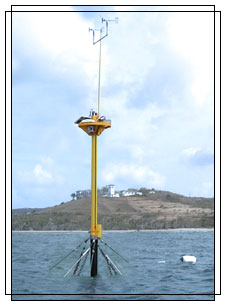|
|
ICON/CREWS
Integrated Coral Observing Network (ICON)
 NOAA
has committed to the installation of meteorological and oceanographic
monitoring stations at all major US
coral reef areas by 2010. These stations consist of a basic suite
of sensors, plus additional ones, depending upon local research the stations
hope to support, and upon available funding. The basic suite of meteorological
and air-based sensors measure air temperature, wind speed and direction,
barometric pressure, photosynthetically available radiation (PAR) and
ultraviolet radiation (UVR). The basic suite of oceanographic sensors
measure salinity, sea temperature, PAR (at 1m nominal) and UVR (at 1m
nominal). In addition to these sensors, a data acquisition system gathers
and averages the data, then transmits the hourly averages via a GOES satellite
to NOAA's National Environmental Satellite, Data and Information Service
(NESDIS) data download facility at Wallops Island, Virginia, where the
data are then acquired in turn via automated procedures for saving and
processing at NOAA's
Atlantic Oceanographic and Meteorological Laboratory (AOML) in Miami,
Florida. Once the data arrive at AOML they are processed with a suite
of expert systems which determine whether the data being received are
within a reasonable range, and whether certain environmental conditions
are conducive to specific marine behavioral events (e.g., bleaching).
The entire data collection and processing system, when used specifically
to understand coral bleaching and coral reef-related events, is called
the Coral Reef Early Warning System (CREWS), and this system is considered
to be part of the Integrated Coral Observing Network (thus ICON/CREWS). NOAA
has committed to the installation of meteorological and oceanographic
monitoring stations at all major US
coral reef areas by 2010. These stations consist of a basic suite
of sensors, plus additional ones, depending upon local research the stations
hope to support, and upon available funding. The basic suite of meteorological
and air-based sensors measure air temperature, wind speed and direction,
barometric pressure, photosynthetically available radiation (PAR) and
ultraviolet radiation (UVR). The basic suite of oceanographic sensors
measure salinity, sea temperature, PAR (at 1m nominal) and UVR (at 1m
nominal). In addition to these sensors, a data acquisition system gathers
and averages the data, then transmits the hourly averages via a GOES satellite
to NOAA's National Environmental Satellite, Data and Information Service
(NESDIS) data download facility at Wallops Island, Virginia, where the
data are then acquired in turn via automated procedures for saving and
processing at NOAA's
Atlantic Oceanographic and Meteorological Laboratory (AOML) in Miami,
Florida. Once the data arrive at AOML they are processed with a suite
of expert systems which determine whether the data being received are
within a reasonable range, and whether certain environmental conditions
are conducive to specific marine behavioral events (e.g., bleaching).
The entire data collection and processing system, when used specifically
to understand coral bleaching and coral reef-related events, is called
the Coral Reef Early Warning System (CREWS), and this system is considered
to be part of the Integrated Coral Observing Network (thus ICON/CREWS).
The CREWS
system has been successful used in modeling and alerts of coral bleaching
conditions in the Florida Keys (Hendee et al 1998; Hendee et al 2001)
and the Great Barrier Reef (Hendee and Berkelmans 2003; Berkelmans et
al 2002), and it is NOAA's intent to expand this alerting capability to
other coral reef areas, and to better refine and enhance its alerting
capabilities beyond coral bleaching (e.g., see Hendee 2000). The development
of the CREWS coral bleaching and other coral reef-related alert and modeling
expert systems are therefore of necessity dependent upon the expertise
of problem domain experts, such as those who study coral bleaching, coral
reef growth, etc.
«Please
click here for literature citations»
|
|

 NOAA
has committed to the installation of meteorological and oceanographic
monitoring stations at all major
NOAA
has committed to the installation of meteorological and oceanographic
monitoring stations at all major